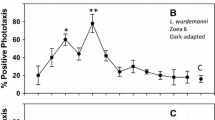Abstract
The light intensity and spectral sensitivities of the calanoid copepod Acartia tonsa Dana were determined by measuring phototactic responses. Adult females displayed only positive phototaxis. The dark-adapted copepod, which possesses a single naupliar eye, perceived light at intensities as low as 2.8x1011 photons m-2 s-1. The action spectrum for positive phototaxis had no clear maxima but rather showed a broad range of greatest sensitivity from 453 to 620 nm. This sensitivity encompassed those wavelengths that are maximally available at the depth where the copepod is found during the day. This spectral overlap, coupled with the finding that the copepod requires light cues for nocturnal vertical miration, suggests that broad spectral sensitivity is an adaptive mechanism to maximize light intensity sensitivity during migration.
Similar content being viewed by others
Literature cited
Barnes, H. and W. Klepal: Phototaxis in Stage I nauplius larvae of two cirripedes. J. exp. mar Biol. Ecol. 10, 267–273 (1972)
Bernard, G. D.: Red-absorbing visual pigment of butterflies. Science, N.Y. 203, 1125–1127 (1979)
Buchanan, C. and N. Goldberg: The action spectrum of Daphnia magna (Crustacea) phototaxis in a simulated natural environment. Photochem. Photobiol 34, 711–717 (1981)
Conover, R. J.: Oceanography of Long Island Sound, 1952–1954. VI. Biology of Acartia clausi and A. tonsa. Bull. Bingham Oceanogr. Coll. 15, 156–233 (1956)
Cronin, T. W.: Factors contributing to the retention of larvae of the crab Rhithropanopeus harrisii in the Newport River estuary, North Carolina, 205 pp. Ph.D. thesis, Department of Zoology, Duke University, Durham, NC 1979
Esterly, C. O.: Specificity in behaviour and the relation between habits in nature and reactions in the laboratory. Univ. Calif. Pub. Zool. 16, 381–392 (1917)
Forward, R. B., Jr.: Light and diurnal vertical migration: photobehavior and photophysiology of plankton. In: Photochemical and photobiological reviews, Vol. 1, pp 157–209. Ed. by K. C. Smith. New York: Plenum Press 1976
Forward, R. B., Jr. and J. D. Costlow, Jr.: The ontogeny of phototaxis by larvae of the crab Rhithropanopeus harrisii. Mar. Biol. 26, 27–33 (1974)
Forward, R. B., Jr. and T. W. Cronin: Spectral sensitivity of larvae from intertidal crustaceans. J. comp. Physiol. 133, 311–315 (1979)
Jerlov, N. G.: Elsevier oceanography series, Vol. 14. Marine optics, 231 pp. New York: Elsevier Science 1976
Lang, W. H., R. B. Forward, Jr. and D. C. Miller: Behavioral responses of Balanus improvisus nauplii to light intensity and spectrum. Biol. Bull. mar. biol. Lab., Woods Hole 157, 166–181 (1979)
McFarland, W. N. and F. W. Munz: The visible spectrum during twilight and its implications to vision. In: Light as an ecological factor: II. The 16th Symposium of the British Ecological Society 26–28 March 1974, pp 249–270. Ed. by G. C. Evans, R. Bainbridge and O. Rackham. London: Blackwell Scientific 1975
Munz, F. W.: The photosensitive retinal pigments of fish from relatively turbid coastal waters. J. gen. Physiol. 42, 445–459 (1958)
Nicol, J. A. C.: Studies on luminescence. Attraction of animals to a weak light. J. mar. biol. Ass. U.K. 38, 477–479 (1959)
Schallek, W.: The vertical migration of the copepod Acartia tonsa under controlled illumination. Biol. Bull. mar. biol. Lab., Woods Hole 82, 112–126 (1942)
Schallek, W.: The reaction of certain Crustacea to direct and to diffuse light. Biol. Bull. mar. biol. Lab., Woods Hole 84, 98–105 (1943)
Sokal, R. R. and F. J. Rohlf: Biometry, 776 pp. San Francisco: W. H. Freeman 1969
Sokal, R. R. and F. J. Rohlf: Biometry (2nd ed.), 859 pp. San Francisco: W. H. Freeman 1981
Stearns, D. E.: Control of nocturnal vertical migration in the calanoid copepod Acartia tonsa Dana in the Newport River estuary, North Carolina, 360 pp. Ph.D. thesis, Department of Zoology, Duke University, Durham, NC 1983
Swift, M. C. and R. B. Forward, Jr.: Photoresponses of Chaoborus larvae. J. Insect Physiol. 26, 365–371 (1980)
Swift, M. C. and R. B. Forward, Jr.: Photoresponses of secondinstar Chaoborus larvae. J. Insect Physiol. 28, 183–187 (1982)
Swift, M. C. and R. B. Forward, Jr.: Photoresponses of the copepod Mesocyclops edax. J. plank. Res. 5, 407–415 (1983)
Author information
Authors and Affiliations
Additional information
Communicated by S. K. Pierce, College Park
Rights and permissions
About this article
Cite this article
Stearns, D.E., Forward, R.B. Photosensitivity of the calanoid copepod Acartia tonsa . Mar. Biol. 82, 85–89 (1984). https://doi.org/10.1007/BF00392766
Accepted:
Issue Date:
DOI: https://doi.org/10.1007/BF00392766




